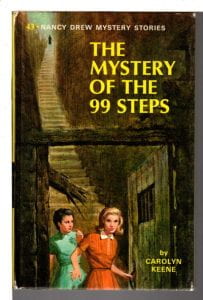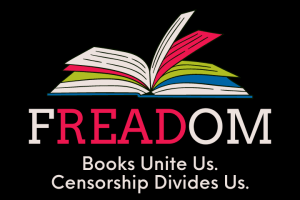One of my favourite places to start my day is our Library Learning Commons as the throngs of students use that time to return books that they’ve completed, browse the inspiring space, enjoy a game of Connect 4, create something with Lego, try their hand at a Rubik’s cube and finally select their next “must read”. I am constantly in awe of Danielle Cadieux, our LLC educator who automatically knows which books to recommend to which students (keeping in mind we have close to 900 students). She encourages them to dive deep into beloved series, explore novels that will provoke their thinking and to challenge themselves with books that may surprise and entertain them.
 Today as two girls were signing out books, I commented how I loved the Nancy Drew series when I was younger. Much to my chagrin, Danielle shared that there was a movement to ban them. Yikes! Really???
Today as two girls were signing out books, I commented how I loved the Nancy Drew series when I was younger. Much to my chagrin, Danielle shared that there was a movement to ban them. Yikes! Really???
So tonight, my social media scroll led me to a number of sites listing Banned or Challenged books. On this Edmonton Public Library site, there were 65 Picture books listed. Some of them I recall from my own childhood, and some were favourites in our home during story time when my own children were young.
I am a firm believer in sharing authentic, thought-provoking literature with children. Books are the perfect vehicle to tackle, discuss and better understand controversial topics. In looking at all 65 titles, there were a few that I could see, in some people’s eyes, could be construed as controversial ~ those sharing stories of same sex partners or perceived violence. But for the most part I was floored when I read the reasons for the “challenge” and shocked at the list.
My kids (both in my home and in my school) loved Thomas’ Snowsuit and yet it was banned by school boards in Niagara ON in 1988 for challenging the authority of a teacher and principal. As I reflect on the reality of school life these days, the least of our worries is students refusing to put on their snowsuits.
I love the fact that Robert Munsch refused to change the ending of the Paper Bag Princess when the publisher was worried about it being anti-family and violent.
The Giving Tree is a classic and one that I have used many, many times over the years to share multi-layered lessons about life, kindness, paying it forward, etc. and yet it was banned in Colorado in 1988 for being sexist and criminalizing the forestry agency. I recall when I was teaching grade 5 years ago and Forestry was one of the units. At no point did we ever consider this text as a book that was criminalizing the forestry agency. Were we naïve or does this seem a little extreme?
If we continue to ban books, I cannot help but wonder what the long-term impact is going to be on our students and society. If we sanitize everything that we expose our students to, how will they learn to critically analyze what is appropriate and what is not? Banning books which have violence in them, does not decrease incidents of violence. For those who are uncomfortable with same sex marriages, banning books with same sex partners will not decrease the number of same sex partnerships.
If anything, we have learned that when we say something is “not available,” suddenly it generates more interest and subsequently more individuals find ways to read it.
The next Nancy Drew book needs to be entitled, “The Mystery of the 99 Banned Books”.

